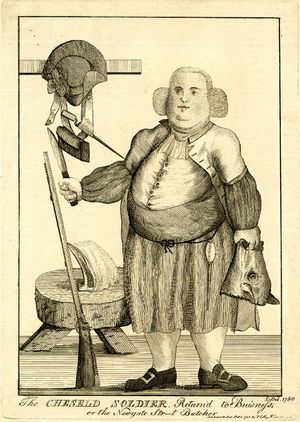Annotation:London Military Association Dance (The): Difference between revisions
No edit summary |
m (Text replacement - "garamond, serif" to "sans-serif") |
||
| (One intermediate revision by one other user not shown) | |||
| Line 1: | Line 1: | ||
'''Back to [[{{BASEPAGENAME}}]]''' | =='''Back to [[{{BASEPAGENAME}}]]'''== | ||
---- | ---- | ||
<p><font face=" | <p><font face="sans-serif" size="4"> | ||
'''LONDON MILITARY ASSOCIATION DANCE.''' English, Country Dance (whole time). D Major. Standard tuning (fiddle). AABB. The London Military Association was a volunteer militia that served to protect London, whose most prominent member was John Wilkes [http://en.wikipedia.org/wiki/John_Wilkes]. The militia saw action in the Gordon Riots of 1780, in which anti-Catholic rioters took over the city for a week, attacking the prisons and freeing the prisoners. Wilkes was in command of the troops outside the Bank of England when he ordered his men to fire on the crowd. | '''LONDON MILITARY ASSOCIATION DANCE.''' English, Country Dance (whole time). D Major. Standard tuning (fiddle). AABB. The London Military Association was a volunteer militia that served to protect London, whose most prominent member was John Wilkes [http://en.wikipedia.org/wiki/John_Wilkes]. The militia saw action in the Gordon Riots of 1780, in which anti-Catholic rioters took over the city for a week, attacking the prisons and freeing the prisoners. Wilkes was in command of the troops outside the Bank of England when he ordered his men to fire on the crowd. | ||
[[File:londonmilitary.jpg| | [[File:londonmilitary.jpg|300px|thumb|left|A period caricature of a volunteer of the London Military Association, a butcher by trade.]] | ||
<br> | <br> | ||
<br> | <br> | ||
</font></p> | </font></p> | ||
<p><font face=" | <p><font face="sans-serif" size="4"> | ||
''Source for notated version'': | ''Source for notated version'': | ||
<br> | <br> | ||
<br> | <br> | ||
</font></p> | </font></p> | ||
<p><font face=" | <p><font face="sans-serif" size="4"> | ||
''Printed sources'': Thompson ('''Compleat Collection of 200 Favourite Country Dances, vol. 5'''), 1788; No. 176, p. 86. | ''Printed sources'': Thompson ('''Compleat Collection of 200 Favourite Country Dances, vol. 5'''), 1788; No. 176, p. 86. | ||
<br> | <br> | ||
<br> | <br> | ||
</font></p> | </font></p> | ||
<p><font face=" | <p><font face="sans-serif" size="4"> | ||
''Recorded sources'': <font color=teal></font> | ''Recorded sources'': <font color=teal></font> | ||
</font></p> | </font></p> | ||
| Line 23: | Line 23: | ||
<br> | <br> | ||
---- | ---- | ||
'''Back to [[{{BASEPAGENAME}}]]''' | =='''Back to [[{{BASEPAGENAME}}]]'''== | ||
Latest revision as of 14:16, 6 May 2019
Back to London Military Association Dance (The)
LONDON MILITARY ASSOCIATION DANCE. English, Country Dance (whole time). D Major. Standard tuning (fiddle). AABB. The London Military Association was a volunteer militia that served to protect London, whose most prominent member was John Wilkes [1]. The militia saw action in the Gordon Riots of 1780, in which anti-Catholic rioters took over the city for a week, attacking the prisons and freeing the prisoners. Wilkes was in command of the troops outside the Bank of England when he ordered his men to fire on the crowd.

Source for notated version:
Printed sources: Thompson (Compleat Collection of 200 Favourite Country Dances, vol. 5), 1788; No. 176, p. 86.
Recorded sources:
